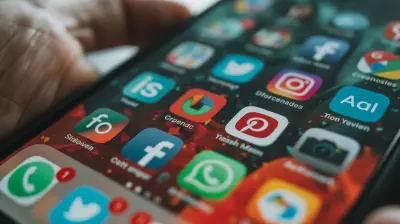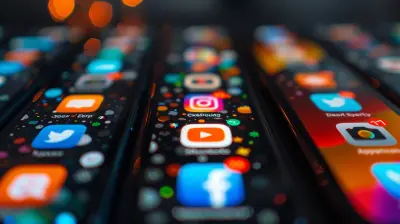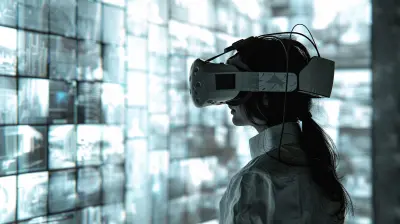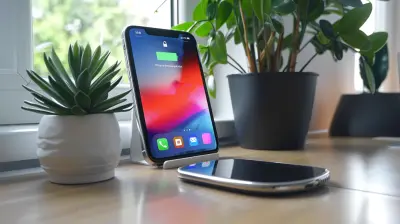Blockchain's Role in the Internet of Things (IoT)
18 April 2025
Introduction
The Internet of Things (IoT) is taking over the world — from smart homes and self-driving cars to industrial automation and supply chain tracking. But with this massive surge of interconnected devices comes a major concern: security and data integrity.
Enter blockchain technology. This revolutionary concept, which powers cryptocurrencies like Bitcoin and Ethereum, is now proving to be a game-changer for IoT. But how exactly does blockchain fit into the IoT ecosystem? And why are industries scrambling to integrate it?
Let’s break it down in a way that makes sense. 
Understanding the Internet of Things (IoT)
At its core, the Internet of Things refers to the network of physical devices that collect and share data over the internet. Think of smart thermostats, wearable fitness trackers, traffic management systems, and even connected refrigerators.How IoT Works
IoT devices have sensors that gather data and send it to a cloud system or centralized server for processing. From there, this data is analyzed, and decisions (automated or manual) are made based on it.For example:
- A smart thermostat adjusts the temperature based on your habits.
- A fitness tracker monitors your heart rate and syncs with your phone.
- A connected car communicates with traffic signals for efficient route planning.
While this interconnected web of devices is impressive, it also presents massive security vulnerabilities. 
The Security Challenges of IoT
Despite its incredible potential, IoT is riddled with challenges. The more devices that connect to the internet, the higher the risk of cyberattacks. Some key issues include:1. Lack of Security Standards
Most IoT devices have weak security protocols. Many manufacturers prioritize affordability and convenience over cybersecurity, making them easy targets for hackers.2. Centralized Networks are Risky
Currently, most IoT systems rely on centralized cloud servers that process and store data. This makes them highly vulnerable to single points of failure—where a hacker only needs to breach one system to access massive amounts of data.3. Data Privacy Concerns
IoT devices collect sensitive personal data, such as health metrics, location, and even daily routines. If these systems are improperly secured, malicious actors can spy on users or steal critical information.Clearly, the IoT ecosystem desperately needs a decentralized, secure, and transparent solution. That’s where blockchain comes in. 
How Blockchain Enhances IoT
Blockchain acts as a distributed digital ledger that records transactions across multiple nodes (computers). Since it’s decentralized, no single entity controls it—making it highly secure and tamper-proof.Here’s how blockchain strengthens IoT:
1. Decentralization Removes Single Points of Failure
Instead of relying on centralized cloud servers, blockchain stores data across multiple nodes. This eliminates a single point of failure, making it exponentially harder for cybercriminals to disrupt IoT systems.2. Enhanced Security Through Encryption
Blockchain uses cryptographic encryption to secure data. Once information is recorded on a blockchain ledger, it cannot be altered or deleted without consensus from the network. This makes hacking nearly impossible.3. Improved Data Integrity and Trust
Because blockchain provides an immutable record, IoT users can trust that the data being collected and shared is authentic and hasn’t been tampered with.4. Transparent and Auditable Transactions
Every transaction recorded on a blockchain is fully auditable. This is particularly useful in industries like healthcare and supply chain management, where data accuracy is critical.5. Smart Contracts for Automation
One of blockchain’s most powerful features is smart contracts—self-executing contracts with predefined rules. For IoT, this means devices can automatically respond to triggers without human intervention.For instance:
- A smart factory could detect a broken machine part and automatically place an order for a replacement.
- A smart car could automatically process toll payments without relying on a centralized system. 
Real-World Applications of Blockchain in IoT
1. Supply Chain Management
IoT devices track goods in real-time, but blockchain ensures that the data is transparent and tamper-proof. Companies like IBM and Walmart are already using blockchain to track food items, ensuring faster responses to contamination outbreaks.2. Healthcare and Medical Devices
IoT-powered medical devices collect patient data, but securing this information is critical. With blockchain, patient records are stored securely and shared only with authorized personnel, minimizing the risk of data breaches.3. Smart Cities
Blockchain can improve IoT-driven traffic management systems, power grids, and waste management by ensuring all sensor data remains secure and authentic.4. Autonomous Vehicles
Self-driving cars rely on massive amounts of real-time data. Blockchain ensures this data remains secure, accurate, and unaltered, reducing the risk of cyberattacks on autonomous vehicles.5. Energy Sector
Blockchain-powered IoT systems can help in peer-to-peer energy trading, where homeowners with solar panels sell excess energy directly to neighbors, bypassing traditional energy companies.Challenges of Implementing Blockchain in IoT
While blockchain offers promising security enhancements, integrating it into IoT isn’t without hurdles.1. Scalability Issues
IoT generates billions of transactions daily. Traditional blockchain networks (like Bitcoin) struggle with slow transaction speeds and high processing costs. Solutions like sharding and layer-2 scaling are being explored, but scalability remains a challenge.2. Storage Constraints
Blockchain requires substantial storage capacity to maintain an ever-growing ledger. Storing massive IoT data streams on-chain can be impractical. Hybrid solutions, where only critical data is stored on-chain, may be necessary.3. Computational Overhead
Many IoT devices are low-power and lightweight (e.g., sensors, wearables). Running blockchain cryptographic functions on these devices could drain their battery life and processing power.4. Regulatory Uncertainty
Blockchain is still evolving, and governments worldwide are struggling to create clear regulations. Industries dealing with strict compliance rules (like healthcare and finance) need to navigate these regulatory uncertainties carefully.The Future of Blockchain and IoT
Despite the challenges, the integration of blockchain and IoT is inevitable. As both technologies mature, we can expect:- More scalable blockchain solutions designed specifically for IoT.
- Hybrid blockchain models that balance security and efficiency.
- Standardized security protocols for IoT to reduce vulnerabilities.
- Wider adoption in industries like healthcare, supply chain, and smart cities.
In a world where billions of devices are constantly exchanging sensitive data, trust and security are non-negotiable. Blockchain isn’t just an option for IoT—it’s becoming a necessity.
Conclusion
IoT is transforming how we interact with technology, but its security challenges cannot be ignored. Blockchain offers a decentralized, tamper-proof, and automated approach that can revolutionize IoT security and efficiency.While hurdles exist, continuous innovations in blockchain technology are paving the way for a more secure and scalable IoT ecosystem. The future is decentralized, and blockchain’s role in IoT is only just beginning.
all images in this post were generated using AI tools
Category:
Blockchain TechnologyAuthor:

Michael Robinson
Discussion
rate this article
9 comments
Velma Frank
Who knew blockchain and IoT could be such a dynamic duo? Like peanut butter and jelly, they’re set to revolutionize our world! Get ready for a future filled with smart toasters and secure transactions—talk about tech serving up delicious possibilities!
May 14, 2025 at 3:52 AM

Michael Robinson
Absolutely! The synergy between blockchain and IoT is indeed transformative, promising innovative solutions and enhanced security in countless applications. Exciting times ahead!
Serenity Hudson
Blockchain can enhance IoT security and interoperability by decentralizing data management and ensuring trust among devices. This synergy not only improves data integrity but also fosters greater collaboration across industries, driving innovation and efficiency in smart ecosystems.
May 1, 2025 at 4:06 AM

Michael Robinson
Absolutely! Blockchain's decentralized approach significantly boosts IoT security and interoperability, paving the way for enhanced data integrity and collaboration across various sectors. This synergy is key to fostering innovation in smart ecosystems.
Tamsin Moore
Connecting worlds, securing futures: blockchain empowers IoT.
April 30, 2025 at 3:08 AM

Michael Robinson
Thank you! Blockchain indeed offers a secure framework for IoT, enhancing connectivity and trust among devices.
Remi Martinez
Great insights! It's fascinating to see how blockchain can enhance security and interoperability in the IoT space. Excited to see where this technology takes us in the future!
April 29, 2025 at 8:33 PM

Michael Robinson
Thank you! I share your excitement about the potential of blockchain to revolutionize security and interoperability in IoT. The future looks promising!
Christina McIntosh
Blockchain and IoT: the tech equivalent of peanut butter meeting jelly—deliciously secure and sticky!
April 27, 2025 at 4:03 AM

Michael Robinson
Thank you! I love that analogy—both technologies indeed complement each other to create a more secure and efficient ecosystem!
Camille Hardy
Blockchain revolutionizes IoT by ensuring secure, transparent interactions. Together, they create a smarter, more connected future where trust and innovation thrive!
April 26, 2025 at 11:00 AM

Michael Robinson
Thank you! I appreciate your perspective on how blockchain enhances IoT by fostering security and transparency, paving the way for a more innovative future.
Lumen Roberson
Connecting worlds, trust woven tight.
April 25, 2025 at 10:35 AM

Michael Robinson
Exactly! Blockchain enhances security and trust, enabling seamless connections in the IoT landscape.
Kaitlyn McCracken
This article succinctly highlights the transformative potential of blockchain in enhancing security and interoperability within IoT ecosystems. It's an insightful read for anyone interested in the future of connected technologies.
April 19, 2025 at 10:50 AM

Michael Robinson
Thank you for your kind words! I'm glad you found the article insightful and that it resonated with your interest in the future of connected technologies.
Matteo McGuire
Blockchain: IoT's cool, nerdy sidekick!
April 18, 2025 at 7:05 PM

Michael Robinson
Absolutely! Blockchain enhances IoT by providing secure, transparent, and decentralized data management, making them a powerful duo for innovation.
MORE POSTS

How to Use Big Data for Competitive Advantage

How to Choose the Right Content Creation Platform for Your Needs

The Top Tools for Creating Scroll-Stopping Social Media Ads

Mastering Cross-Platform App Development: A Comprehensive Guide

Virtual Reality Tools That Are Shaping the Future of Content

Wireless Chargers Compared: Which One Is the Fastest?

Harnessing the Power of AI in Your Content Creation Process